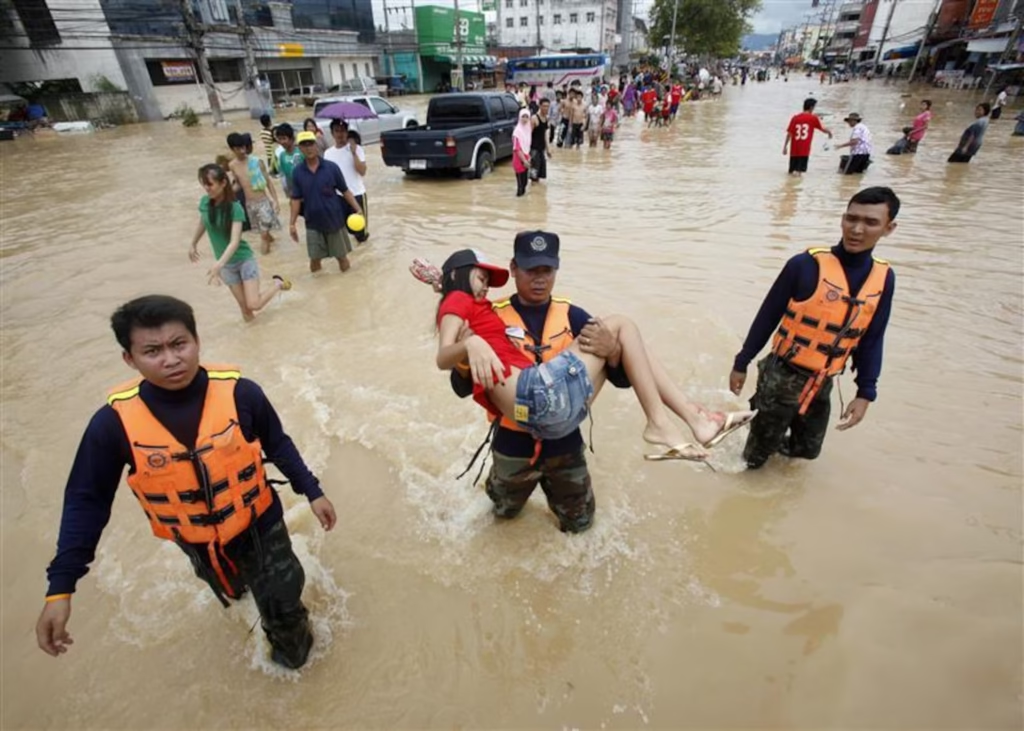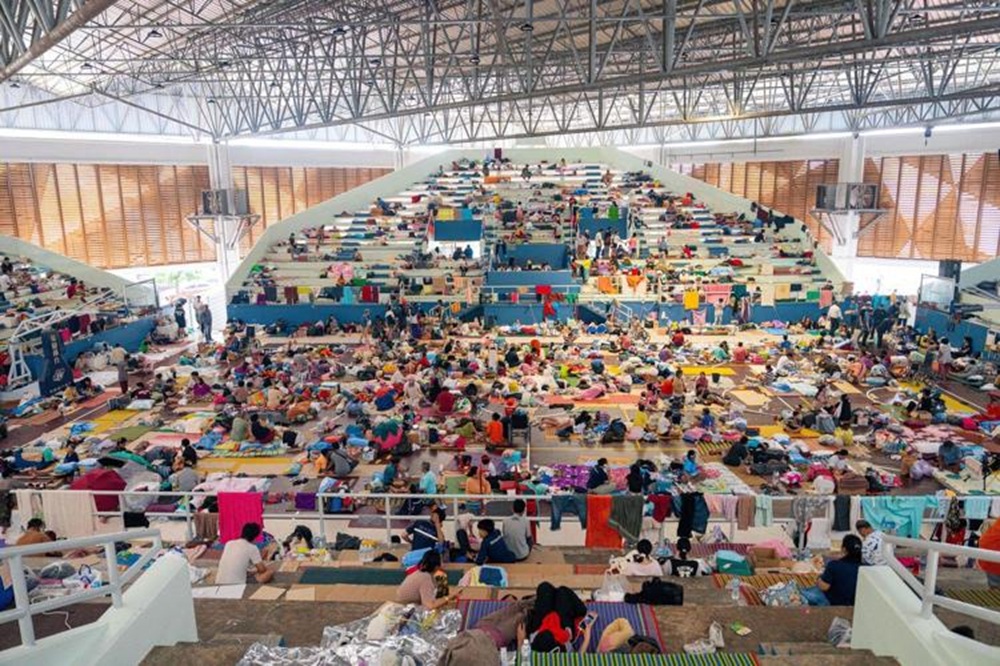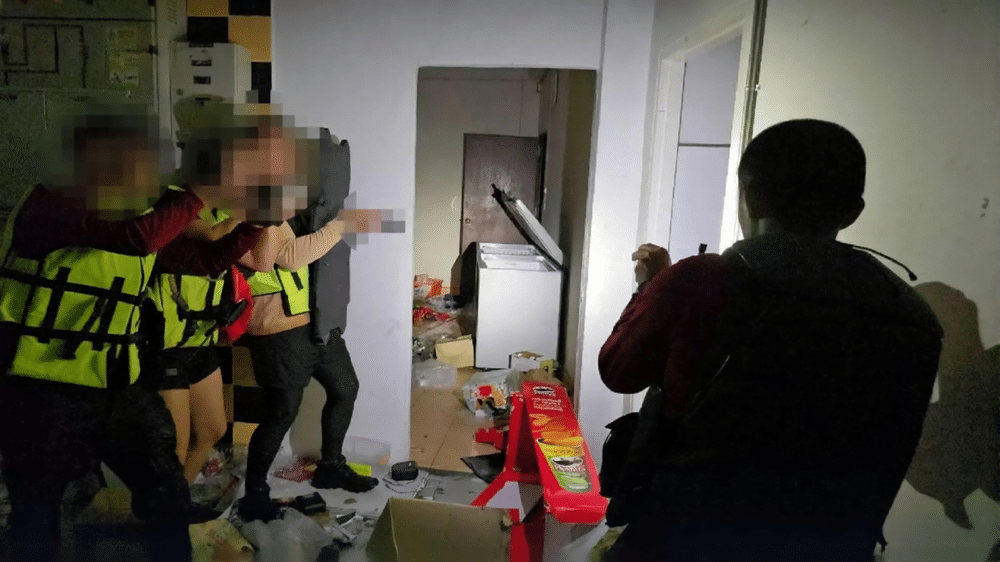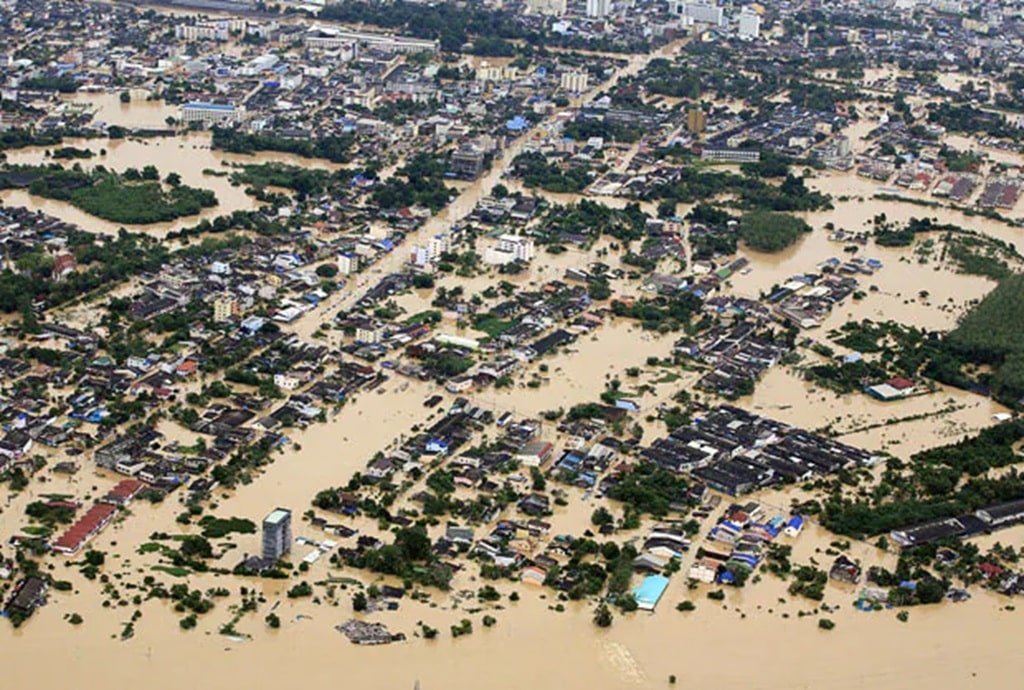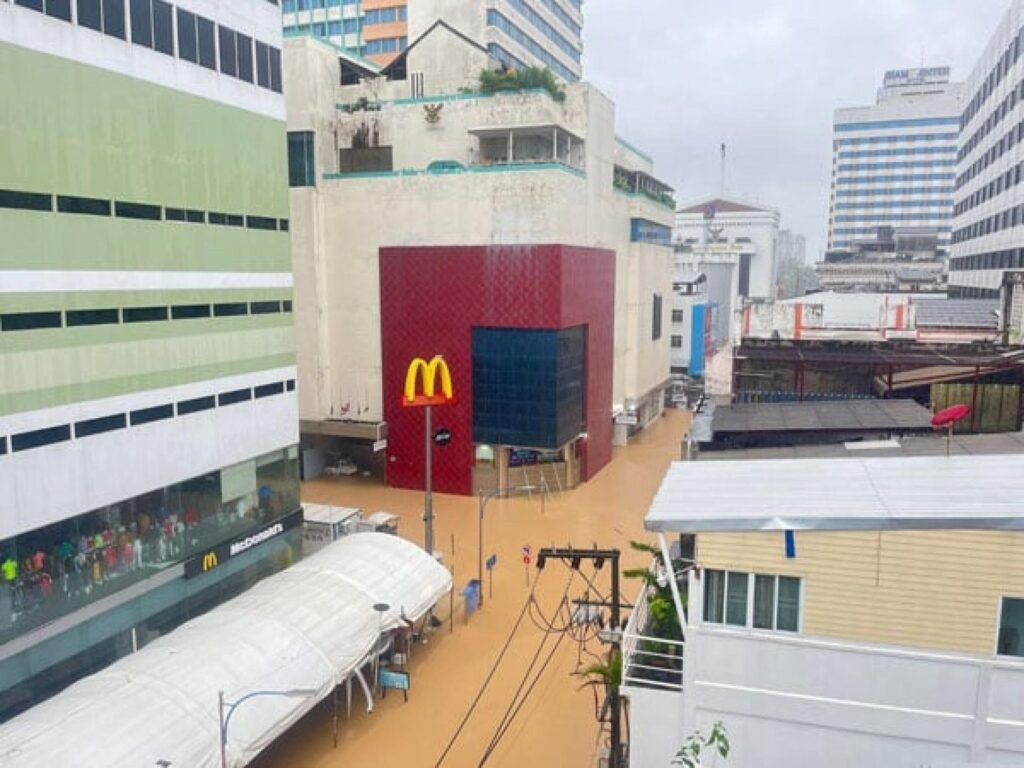SONGKHLA – Southern Thailand is now dealing with the fallout from severe flooding that has killed 145 people, displaced thousands, and hit the regional economy hard. The government’s Emergency Flood Response Operations Centre reports that the death toll has climbed quickly as water levels drop and rescue teams gain access to previously cut-off neighbourhoods.
Songkhla province, and especially the busy trading city of Hat Yai, has been hit hardest, with 110 confirmed deaths so far. Officials say this is the most serious flooding the South has seen in more than ten years. The scale of the impact already exceeds previous disasters in the region, and some experts are comparing the intensity of the rainfall to events that only occur a few times in a century.
As of Friday, 28 November 2025, more than 14,160 people are still staying in temporary shelters. These sites can take around 20,840 more evacuees if needed. The flooding has affected over 3.6 million people in 12 provinces, disrupting work, schooling, and everyday life.
The government has placed a strong focus on getting people out of danger. Military helicopters and boats have been working non-stop to reach stranded residents, move patients from flooded hospitals, and deliver food and drinking water to isolated communities.
As floodwaters fall in Hat Yai, reports of looting are adding a new layer of stress for residents and shop owners. Convenience stores and brewery facilities have been targeted, with thieves taking drinks, cigarettes, and other goods.
In response, police have stepped up patrols, and authorities are urging people to keep an eye out for suspicious activity. Officials say maintaining order is important, but getting aid to those in need remains the top priority.
Economic Impact of the Southern Thailand Flooding
Early estimates put the economic losses at up to 25 billion baht (about 776 million US dollars). Key areas hit include farming, tourism, local trade, and small businesses.
Rubber plantations, a core part of the southern economy and a major export earner, may lose around 140 million US dollars in output. At the same time, power lines, roads, and water systems have all suffered damage. Work to restore electricity and clean water is underway, with the government aiming to bring services back to normal by 29 November.
Relentless monsoon rains across southern Thailand through November 2025 have left behind a humanitarian and economic crisis on a massive scale. What started as routine seasonal rain soon turned into a torrent that meteorologists say produced record-breaking totals in some locations. Entire neighbourhoods were flooded, roads and railways went underwater, and many families lost homes, jobs, or loved ones.
By Friday, 28 November, the Emergency Flood Response Operations Centre confirmed 145 deaths. Songkhla province accounts for 110 of those, which reflects how exposed this low-lying region is when heavy rain and swollen rivers converge.
This has become the worst flood event to hit southern Thailand in more than a decade and has highlighted serious gaps in flood planning, climate adaptation, and urban design.
The floods were driven by a mix of intense weather conditions, including heavy rain linked to a strong northeast monsoon and possible effects of climate change. The Thai Meteorological Department reports that Hat Yai, the main commercial hub in Songkhla, recorded an astonishing 335 millimetres of rain in a single day on 21 November, described as the highest daily total in about 300 years for the city.
Rainfall Exceeded 630 Millimetres
Over three days, rainfall in Hat Yai exceeded 630 millimetres, which triggered flash floods and pushed rivers over their banks, swamping large areas in 12 provinces: Nakhon Si Thammarat, Phatthalung, Songkhla, Trang, Satun, Pattani, Yala, Narathiwat, Surat Thani, Krabi, Chumphon, and Ranong.
Experts say the intensity for the south surpasses the 2011 floods, although those earlier floods affected more parts of the country. Seasonal monsoon rain is nothing new, but many scientists warn that heavier and more frequent events linked to global warming are turning normal wet seasons into deadly emergencies.
Among all the affected areas, Songkhla stands out for the scale of loss. The province, which has more than 1.5 million residents and plays a key trade role near the Malaysian border, saw the number of deaths rise sharply as waters dropped and bodies were recovered from homes, shops, and vehicles.
Data from the Operations Centre show the spread of fatalities across the region: 9 deaths in Nakhon Si Thammarat, 4 in Phatthalung, 2 in Trang, 5 in Satun, 6 in Pattani, 5 in Yala, and 4 in Narathiwat.
These figures highlight how heavily Songkhla has been affected in comparison. Many of the victims were older people or those with existing health problems who were unable to escape rising water or who were caught in fast-moving floods.
In Hat Yai, a city of around 150,000 residents, water levels reached chest height in some neighbourhoods. Families had to be moved out of flooded hospitals, apartment blocks, and terraced housing. Hat Yai Hospital, a major regional treatment centre, relocated about 600 patients, including around 50 in intensive care, using military helicopters and specialist medical teams.
Evacuation and rescue work has been huge in scale and tightly coordinated by the Emergency Flood Response Operations Centre, which operates under the Prime Minister’s Office. As of Friday, 14,160 people were still staying in emergency shelters across the 12 provinces, with spare capacity for a further 20,840 people if conditions worsen.
In total, more than 14,000 people have been formally evacuated from their homes so far, alongside 453 medical evacuations for urgent cases. The Royal Thai Armed Forces have taken on a central role. Army teams are running boat missions into flooded streets and delivering supplies. They have handed out about 175,980 meal sets and 92,320 ready-to-eat food packs.
Looting in Hat Yai
The Navy has used S-76B helicopters to transfer critical patients to Songklanagarind Hospital on higher ground. The Air Force has set up temporary field hospitals at Hat Yai International Airport to ease pressure on damaged medical facilities.
Joint patrols involving police, soldiers, and local volunteers are trying to protect property as families return to half-flooded homes. Large-scale cleaning drives, branded as “Big Cleaning Day” events, are planned in urban centres once water levels drop further.
As physical dangers from fast-moving water ease, new risks are coming into focus. Reports of looting in Hat Yai are causing anger and anxiety among residents. Some groups have broken into stranded freight carriages at Hat Yai railway station and taken boxes of Chang beer.
Thieves have also targeted Boonrawd Brewery’s distribution depot, taking cases of Leo and Singha.
One 7-Eleven store in the area known as “District 8” was cleared of drinks, cigarettes, and other stock worth more than 100,000 baht by a group of five suspects. A teenager allegedly involved in the theft even posted about it online, triggering a strong reaction and leading police to speed up inquiries.
Deputy police spokesman Pol Maj Gen Siriwat Deepor said officers used trucks and boats to reach the flooded area, but the suspects had fled by the time they arrived. An executive at Boonrawd said the company is focused on helping flood victims first and will pursue legal cases later. These incidents have reminded many people of looting during past floods and raised concerns about how to keep streets safe while so many homes and shops lie empty.
The broader economic damage is severe. Early assessments from banks, government agencies, and business groups suggest total losses of around 23.6 to 25 billion baht, or roughly 734 to 776 million US dollars. Daily losses to trade and tourism alone are thought to be between 1 and 1.5 billion baht, as markets, shops, and tourist sites close.
Over a Million People Affected
Small and medium-sized enterprises (SMEs) could lose up to 15 billion baht through damaged buildings, ruined stock, and long closures. Rubber plantations could lose about 4.5 billion baht in value, which corresponds to a cut of around 400,000 tonnes of output. Since the south is a key rubber-growing area, this is expected to affect export volumes and global supply.
Around 1.9 million people in 10 of the flooded provinces have been directly affected. Roughly 980,000 homes have reported some type of flood damage, from minor waterlogging to full-scale destruction. Large areas of farmland remain underwater, and analysts warn the floods could shave about 0.13 percent off national GDP if conditions persist.
In Phatthalung province alone, local authorities estimate that losses have already topped 100 million baht, with every district affected. Tourism, especially in popular seaside and island destinations like Krabi and Surat Thani, has been badly hit. Hotels are closed, bookings cancelled, and tour operators have paused services.
Repairing infrastructure is proving slow and complex. Some main and secondary roads still cannot be used because of standing water, deep potholes, or landslides. Power poles and transformers have been knocked over, leaving pockets of homes in the dark. Streets are littered with debris, from damaged cars and broken furniture to fallen trees.
The government has promised that electricity and water supplies will be fully restored by 29 November, where technically possible. Telecoms companies have offered free calls and data packages in some of the affected areas to help families stay in touch and request help.
Financial support plans include a payment of 9,000 baht per affected household to help with urgent repairs and essentials.
Prime Minister Paetongtarn Shinawatra is expected to announce extra relief measures during an upcoming visit to Hat Yai. Community volunteers and charities are already out in force, distributing cleaning gear such as brooms, shovels, gloves, and disinfectant, and helping clear mud from homes and shops.
Health Risks as Water Recedes
Health risks are a growing worry now that the floodwater is starting to stagnate. Standing water encourages mosquitoes and bacteria, raising the odds of dengue fever, flu, skin infections, and diarrhoeal disease. In response, health authorities have delivered 5,000 flu vaccine doses and additional oxygen tanks to hospitals and clinics in the worst-hit areas.
The Ministry of Environment is sending mobile units to provide clean drinking water, while temporary clinics and field hospitals treat injuries and flood-related illnesses. Social media, especially platforms like X, have become informal lifelines. Drone footage and video clips show neighbourhoods still underwater, damaged homes, queues for food, and appeals for medical help.
So far, more than 1,900 calls for assistance have been logged through these channels, with around 1,734 already handled by local teams, according to official tallies.
This disaster is part of a wider pattern across Southeast Asia, where heavy rain and floods have battered several countries at the same time. Malaysia and Indonesia have also reported rising death tolls, and regional media say more than 250 people have died across the region this monsoon season.
Inside Thailand, anger and concern are building over how prepared the state was for such severe flooding. Critics say weather warnings were too slow and that drainage systems, flood defences, and city planning are not keeping pace with more extreme rainfall.
Officials argue that agencies moved quickly once the scale of the storm became clear and that some events were hard to predict.
Looking ahead, engineers, planners, and climate experts are calling for better flood barriers, improved river management, reforestation in upland areas, and stricter rules on building in known floodplains. They say long-term investment is needed if the country is to cope with heavier rainfall events linked to a warming climate.
Despite the scale of the tragedy, there are many stories of kindness and solidarity. Neighbours have helped each other evacuate, shared food, and sheltered families whose homes have been destroyed. Local groups and volunteers have cooked meals, run donation drives, and ferried elderly residents through flooded streets in small boats or pickup trucks.
Thunderstorms are still forecast for parts of the south, so authorities are urging people to stay alert and avoid unnecessary travel near rivers and canals. The rest of the country is watching closely as southern communities begin the long and difficult task of rebuilding homes, lives, and livelihoods.
Flood Impact by Province: Key Statistics
| Province | Fatalities | Affected Households (Estimated) | Key Issues Noted |
|---|---|---|---|
| Songkhla | 110 | Over 400,000 | Looting, hospital evacuations, and heavily flooded city districts |
| Nakhon Si Thammarat | 9 | 150,000 | River overflows, major damage to farmland |
| Phatthalung | 4 | 100,000 | Widespread flooding in all districts, damaged local roads |
| Trang | 2 | 50,000 | Disrupted transport routes, tourism slowdown |
| Satun | 5 | 60,000 | Coastal flooding, crowded evacuation centres |
| Pattani | 6 | 80,000 | Flash floods, higher disease risk |
| Yala | 5 | 70,000 | Large clean-up needs, scattered power cuts |
| Narathiwat | 4 | 90,000 | Border logistics issues, slower aid delivery |
| Others (Combined) | 0 | 250,000 | Localised floods, support and relief operations |
(Data compiled from government updates and field assessments as of 28 November 2025.)
Economic Sector Breakdown
| Sector | Estimated Losses (Baht) | Impact Description |
|---|---|---|
| Agriculture (Rubber) | 4.5 billion | Output cut by about 400,000 tonnes, export disruption |
| SMEs | Up to 15 billion | Damaged premises, lost inventory, long closures |
| Tourism | 5–7 billion | Hotel shutdowns, trip cancellations, and reduced arrivals |
| Trade/Retail | 1–1.5 billion daily | Broken supply chains, shop closures, theft-related loss |
| Infrastructure | 3–5 billion | Road repair, bridge maintenance, power, and water works |
| Total | 23.6–25 billion | Possible 0.13% reduction in national GDP if prolonged |
(Sources: Krungsri Research, OSMEP, and official government estimates.)
This summary brings together official data and on-the-ground reporting to show the scale of the challenges facing southern Thailand. As Chiang Rai Times tracks the situation, thoughts remain with families who have lost loved ones, and gratitude goes to all the rescuers, medical staff, volunteers, and community groups working around the clock to help.





